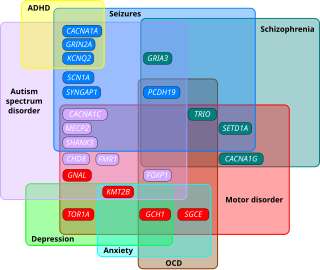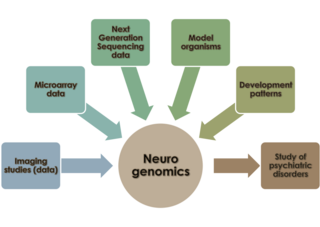Related Research Articles
Psychosis is a condition of the mind that results in difficulties determining what is real and what is not real. Symptoms may include delusions and hallucinations, among other features. Additional symptoms are incoherent speech and behavior that is inappropriate for a given situation. There may also be sleep problems, social withdrawal, lack of motivation, and difficulties carrying out daily activities. Psychosis can have serious adverse outcomes.

Savant syndrome is a phenomenon where someone demonstrates exceptional aptitude in one domain, such as art or mathematics, despite significant social or intellectual impairment.
In psychology, schizotypy is a theoretical concept that posits a continuum of personality characteristics and experiences, ranging from normal dissociative, imaginative states to extreme states of mind related to psychosis, especially schizophrenia. The continuum of personality proposed in schizotypy is in contrast to a categorical view of psychosis, wherein psychosis is considered a particular state of mind, which the person either has or does not have.

Autism spectrum disorders (ASD) are neurodevelopmental disorders that begin in early childhood, persist throughout adulthood, and affect three crucial areas of development: communication, social interaction and restricted patterns of behavior. There are many conditions comorbid to autism spectrum disorders such as attention-deficit hyperactivity disorder and epilepsy.

The heritability of autism is the proportion of differences in expression of autism that can be explained by genetic variation; if the heritability of a condition is high, then the condition is considered to be primarily genetic. Autism has a strong genetic basis. Although the genetics of autism are complex, autism spectrum disorder (ASD) is explained more by multigene effects than by rare mutations with large effects.

Many causes of autism, including environmental and genetic factors, have been recognized or proposed, but understanding of the theory of causation of autism is incomplete. Attempts have been made to incorporate the known genetic and environmental causes into a comprehensive causative framework. ASD is a neurodevelopmental disorder marked by impairments in communicative ability and social interaction and restricted/repetitive behaviors, interests, or activities not suitable for the individual's developmental stage. The severity of symptoms and functional impairment vary between individuals.
The Olduvai domain, known until 2018 as DUF1220 and the NBPF repeat, is a protein domain that shows a striking human lineage-specific (HLS) increase in copy number and appears to be involved in human brain evolution. The protein domain has also been linked to several neurogenetic disorders such as schizophrenia and increased severity of autism. In 2018, it was named by its discoverers after Olduvai Gorge in Tanzania, one of the most important archaeological sites for early humans, to reflect data indicating its role in human brain size and evolution.
Schizophrenia is a neurodevelopmental disorder with no precise or single cause. Schizophrenia is thought to arise from multiple mechanisms and complex gene–environment interactions with vulnerability factors. Risk factors of schizophrenia have been identified and include genetic factors, environmental factors such as experiences in life and exposures in a person's environment, and also the function of a person's brain at it develops. The interactions of these risk factors are intricate, as numerous and diverse medical insults from conception to adulthood can be involved. Many theories have been proposed including the combination of genetic and environmental factors may lead to deficits in the neural circuits that affect sensory input and cognitive functions.

Gamma-aminobutyric acid receptor subunit beta-3 is a protein that in humans is encoded by the GABRB3 gene. It is located within the 15q12 region in the human genome and spans 250kb. This gene includes 10 exons within its coding region. Due to alternative splicing, the gene codes for many protein isoforms, all being subunits in the GABAA receptor, a ligand-gated ion channel. The beta-3 subunit is expressed at different levels within the cerebral cortex, hippocampus, cerebellum, thalamus, olivary body and piriform cortex of the brain at different points of development and maturity. GABRB3 deficiencies are implicated in many human neurodevelopmental disorders and syndromes such as Angelman syndrome, Prader-Willi syndrome, nonsyndromic orofacial clefts, epilepsy and autism. The effects of methaqualone and etomidate are mediated through GABBR3 positive allosteric modulation.
Asociality refers to the lack of motivation to engage in social interaction, or a preference for solitary activities. Asociality may be associated with avolition, but it can, moreover, be a manifestation of limited opportunities for social relationships. Developmental psychologists use the synonyms nonsocial, unsocial, and social uninterest. Asociality is distinct from, but not mutually exclusive to, anti-social behavior. A degree of asociality is routinely observed in introverts, while extreme asociality is observed in people with a variety of clinical conditions.

Neurogenomics is the study of how the genome of an organism influences the development and function of its nervous system. This field intends to unite functional genomics and neurobiology in order to understand the nervous system as a whole from a genomic perspective.

Autism, formally called autism spectrum disorder (ASD) or autism spectrum condition (ASC), is a neurodevelopmental disorder marked by deficits in reciprocal social communication and the presence of restricted and repetitive patterns of behavior. Other common signs include difficulties with social interaction, verbal and nonverbal communication, along with perseverative interests, stereotypic body movements, rigid routines, and hyper- or hyporeactivity to sensory input. Autism is clinically regarded as a spectrum disorder, meaning that it can manifest very differently in each person. For example, some are nonspeaking, while others have proficient spoken language. Because of this, there is wide variation in the support needs of people across the autism spectrum.
Childhood schizophrenia is similar in characteristics of schizophrenia that develops at a later age, but has an onset before the age of 13 years, and is more difficult to diagnose. Schizophrenia is characterized by positive symptoms that can include hallucinations, delusions, and disorganized speech; negative symptoms, such as blunted affect and avolition and apathy, and a number of cognitive impairments. Differential diagnosis is problematic since several other neurodevelopmental disorders, including autism spectrum disorder, language disorder, and attention deficit hyperactivity disorder, also have signs and symptoms similar to childhood-onset schizophrenia.

The imprinted brain hypothesis is an unsubstantiated hypothesis in evolutionary psychology regarding the causes of autism spectrum and schizophrenia spectrum disorders, first presented by Bernard Crespi and Christopher Badcock in 2008. It claims that certain autistic and schizotypal traits are opposites, and that this implies the etiology of the two conditions must be at odds.
Autism spectrum disorder (ASD) refers to a variety of conditions typically identified by challenges with social skills, communication, speech, and repetitive sensory-motor behaviors. The 11th International Classification of Diseases (ICD-11), released in January 2021, characterizes ASD by the associated deficits in the ability to initiate and sustain two-way social communication and restricted or repetitive behavior unusual for the individual's age or situation. Although linked with early childhood, the symptoms can appear later as well. Symptoms can be detected before the age of two and experienced practitioners can give a reliable diagnosis by that age. However, official diagnosis may not occur until much older, even well into adulthood. There is a large degree of variation in how much support a person with ASD needs in day-to-day life. This can be classified by a further diagnosis of ASD level 1, level 2, or level 3. Of these, ASD level 3 describes people requiring very substantial support and who experience more severe symptoms. ASD-related deficits in nonverbal and verbal social skills can result in impediments in personal, family, social, educational, and occupational situations. This disorder tends to have a strong correlation with genetics along with other factors. More research is identifying ways in which epigenetics is linked to autism. Epigenetics generally refers to the ways in which chromatin structure is altered to affect gene expression. Mechanisms such as cytosine regulation and post-translational modifications of histones. Of the 215 genes contributing, to some extent in ASD, 42 have been found to be involved in epigenetic modification of gene expression. Some examples of ASD signs are specific or repeated behaviors, enhanced sensitivity to materials, being upset by changes in routine, appearing to show reduced interest in others, avoiding eye contact and limitations in social situations, as well as verbal communication. When social interaction becomes more important, some whose condition might have been overlooked suffer social and other exclusion and are more likely to have coexisting mental and physical conditions. Long-term problems include difficulties in daily living such as managing schedules, hypersensitivities, initiating and sustaining relationships, and maintaining jobs.
The evolution of schizophrenia refers to the theory of natural selection working in favor of selecting traits that are characteristic of the disorder. Positive symptoms are features that are not present in healthy individuals but appear as a result of the disease process. These include visual and/or auditory hallucinations, delusions, paranoia, and major thought disorders. Negative symptoms refer to features that are normally present but are reduced or absent as a result of the disease process, including social withdrawal, apathy, anhedonia, alogia, and behavioral perseveration. Cognitive symptoms of schizophrenia involve disturbances in executive functions, working memory impairment, and inability to sustain attention.
Joseph D. Buxbaum is an American molecular and cellular neuroscientist, autism researcher, and the Director of the Seaver Autism Center at the Icahn School of Medicine at Mount Sinai. Buxbaum is also, along with Simon Baron-Cohen, the co-editor of the BioMed Central journal Molecular Autism, and is a member of the scientific advisory board of the Autism Science Foundation. Buxbaum is a Professor of Psychiatry, Neuroscience, and Genetics and Genomic Sciences. He is also the Vice Chair for Research and for Mentoring in the Department of Psychiatry at the Icahn School of Medicine at Mount Sinai.
Evolutionary psychiatry, also known as Darwinian psychiatry, is a theoretical approach to psychiatry that aims to explain psychiatric disorders in evolutionary terms. As a branch of the field of evolutionary medicine, it is distinct from the medical practice of psychiatry in its emphasis on providing scientific explanations rather than treatments for mental disorder. This often concerns questions of ultimate causation. For example, psychiatric genetics may discover genes associated with mental disorders, but evolutionary psychiatry asks why those genes persist in the population. Other core questions in evolutionary psychiatry are why heritable mental disorders are so common how to distinguish mental function and dysfunction, and whether certain forms of suffering conveyed an adaptive advantage. Disorders commonly considered are depression, anxiety, schizophrenia, autism, eating disorders, and others. Key explanatory concepts are of evolutionary mismatch and the fact that evolution is guided by reproductive success rather than health or wellbeing. Rather than providing an alternative account of the cause of mental disorder, evolutionary psychiatry seeks to integrate findings from traditional schools of psychology and psychiatry such as social psychology, behaviourism, biological psychiatry and psychoanalysis into a holistic account related to evolutionary biology. In this sense, it aims to meet the criteria of a Kuhnian paradigm shift.
Sex and gender differences in autism exist regarding prevalence, presentation, and diagnosis.

Bernard Joseph Crespi is an American professor of evolutionary biology at Simon Fraser University in British Columbia, Canada. His research focuses on social evolution across multiple scales, using genetic and ecological approaches. He is one of the initiators of the imprinted brain hypothesis.
References
- ↑ Husbands, Christopher T. (14 March 2019). Sociology at the London School of Economics and Political Science, 1904–2015: Sound and Fury. Springer. p. 148. ISBN 978-3-319-89450-8.
- ↑ Science, London School of Economics and Political. "Christopher Robert Badcock". London School of Economics and Political Science. Retrieved 6 July 2020.
- ↑ Badcock, Christopher (June 2011). "The imprinted brain: how genes set the balance between autism and psychosis" (PDF). Epigenomics. 3 (3): 345–359. doi:10.2217/epi.11.19. ISSN 1750-192X. PMID 22122342.
- ↑ Crespi, Bernard; Badcock, Christopher (June 2008). "Psychosis and autism as diametrical disorders of the social brain" (PDF). Behavioral and Brain Sciences. 31 (3): 241–261, discussion 261–320. doi:10.1017/S0140525X08004214. ISSN 1469-1825. PMID 18578904.
- ↑ Carey, Benedict (10 November 2008). "In a Novel Theory of Mental Disorders, Parents' Genes Are in Competition". The New York Times. ISSN 0362-4331 . Retrieved 6 July 2020.